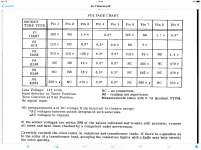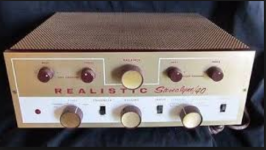I know there had been a few threads about this and I looked them up. However, I stil have some unanswered questions that I hope some of you experts could help me with:
What are the differences between Heathkit Ea-2 and Ea-3 Heathkit amplifiers. Do they have the same output and v
high voltage tranformers with different voltages on the EL84's. Your information and input is greatly appreciated.
What are the differences between Heathkit Ea-2 and Ea-3 Heathkit amplifiers. Do they have the same output and v
high voltage tranformers with different voltages on the EL84's. Your information and input is greatly appreciated.
I see a couple of differences between the EA2 and the EA3. The 2's output stage uses a 110 ohm unbypassed common cathode resistor for biasing. The 3 uses a 210 ohm bypassed common cathode resistor. This runs the EL84s a little more into class AB1 then the 2 does. The 3 also uses a 6AU6 pentode line stage to provide a little more gain to drive the outputs. (14 watts verses 12 watts) I suspect the transformers are the same. But without part numbers one can't be sure. Both schematics are here.
EA-3 seems to have quite extreme values, 370 V at the plate, 15.5 V at the cathode and 210 ohms common cathode resistor.
Based on this the anode current of each EL84 is some 35 mA (Ig2~2 mA).
EA-2 seems more conventional. Voltages at different points are not given, but based on the 110 ohms common cathode resistor, it is obvious that the anode voltage is essentially lower and anode current higher. Values of 250...300 V at the plate and Ia ~40...45 mA seems likely.
Based on the above differences, the output transformer and power transformer should not be same types on EA-2 and EA-3.
Based on this the anode current of each EL84 is some 35 mA (Ig2~2 mA).
EA-2 seems more conventional. Voltages at different points are not given, but based on the 110 ohms common cathode resistor, it is obvious that the anode voltage is essentially lower and anode current higher. Values of 250...300 V at the plate and Ia ~40...45 mA seems likely.
Based on the above differences, the output transformer and power transformer should not be same types on EA-2 and EA-3.
EA-3 seems to have quite extreme values, 370 V at the plate, 15.5 V at the cathode and 210 ohms common cathode resistor.
Based on this the anode current of each EL84 is some 35 mA (Ig2~2 mA).
EA-2 seems more conventional. Voltages at different points are not given, but based on the 110 ohms common cathode resistor, it is obvious that the anode voltage is essentially lower and anode current higher. Values of 250...300 V at the plate and Ia ~40...45 mA seems likely.
Per the manual, Vp = 370V, Vg2 = 365V, Vk = 12V. So the bias is bit hotter than the EA-3.
Both the EA-2 and EA-3 used the 51-30 OPT, not sure about the PT... but most likely the same as well.Based on the above differences, the output transformer and power transformer should not be same types on EA-2 and EA-3.
Per the manual, Vp = 370V, Vg2 = 365V, Vk = 12V. So the bias is bit hotter than the EA-3.
Are these really values for EA-2 ??
In such case, with common 110 ohms cathode resistor, the anode dissipation would be almost 18 W. Max. plate dissipation specs is 12 W.
Does not seem very likely.
Do you have this manual or link ?
Last edited:
I can only find the schematic, but no manual.
Would you mind to share the link you mentioned ?
EDIT: I found this: Login failure.
But it requires to create an account, which I don't do.
Is your link this ?
Would you mind to share the link you mentioned ?
EDIT: I found this: Login failure.
But it requires to create an account, which I don't do.
Is your link this ?
Last edited:
Thanks.
It seems to me, that there is something wrong. EL84 can not be designed to dissipate 17...18 W/tube in case of commercial product.
And is the output power of EA-2 specified as 12 W ? It should be essentially bigger if the values in the manual are correct.
I send you a pm. to concerning the manual.
It seems to me, that there is something wrong. EL84 can not be designed to dissipate 17...18 W/tube in case of commercial product.
And is the output power of EA-2 specified as 12 W ? It should be essentially bigger if the values in the manual are correct.
I send you a pm. to concerning the manual.
Heathkit has deliberately pushed to the limit. At the page 31 of the manual is given a warning:
Obviously this happens when a 12 W tube is run at 17...18 W.
HOT TUBES: Under normal operating conditions, the elements of the EL84 output tubes may have a red glow to them.
Obviously this happens when a 12 W tube is run at 17...18 W.
This was very common practice in the power hungry U.S. market, there are unfortunately lots of designs running 6BQ5 well beyond their ratings.
I had a Realistic amp (Stereolyne 40) which I gave away a few years ago as did my dad back in the day (different amps) that ran Japanese made 6BQ5 at a cathode current of 50mA each on a 400V supply for 20W of combined plate/screen dissipation. They rated this stereo amp at 20Wrms per channel, in measurements above 50Hz it met this claim with a wee bit of margin to spare.
HH Scott ran them hard too, but at least used 7189 and switched finally to 7189A in their smaller amps. Plate voltages of north of 400V are common in these amps. The Scott integrated amps were mostly rated for 117V AC line operation which is not far removed from our nominal line voltage today.
I had a Realistic amp (Stereolyne 40) which I gave away a few years ago as did my dad back in the day (different amps) that ran Japanese made 6BQ5 at a cathode current of 50mA each on a 400V supply for 20W of combined plate/screen dissipation. They rated this stereo amp at 20Wrms per channel, in measurements above 50Hz it met this claim with a wee bit of margin to spare.
HH Scott ran them hard too, but at least used 7189 and switched finally to 7189A in their smaller amps. Plate voltages of north of 400V are common in these amps. The Scott integrated amps were mostly rated for 117V AC line operation which is not far removed from our nominal line voltage today.
Attachments
I have pieces of a Heath EA-3 here. There's some controversy about which output transformers are for which models. Might not be the same one for both models. Is there a parts list with part numbers in the EA-3 manual? If so, what's the part number shown there for the OPT (T2)? 51-30?
thanks
thanks
I have 3-4 of each ea2 and ea3. I had to buy this many years ago when you could score one for like 25$ off ebay. I had to buy this many to arrive at a perfect matched pair of power and -29 opt iron down to part # and lam thickness.
The -29 transformers are supposed to be the better but I have one 29 with less lams than my biggest -30. So they aren't all the same by the part # and manufacturer alone.
51-29 and 51-30 transformers are used interchangeably it seems, and both have at least 2 different lam stack thicknesses in my samples alone.
Also have three different power transformers. Two different part #s as well as lam stack height difference again.
The -29 transformers are supposed to be the better but I have one 29 with less lams than my biggest -30. So they aren't all the same by the part # and manufacturer alone.
51-29 and 51-30 transformers are used interchangeably it seems, and both have at least 2 different lam stack thicknesses in my samples alone.
Also have three different power transformers. Two different part #s as well as lam stack height difference again.
Last edited:
- Status
- This old topic is closed. If you want to reopen this topic, contact a moderator using the "Report Post" button.
- Home
- Amplifiers
- Tubes / Valves
- Details of Heathkit Ea-2 vs Ea-3

